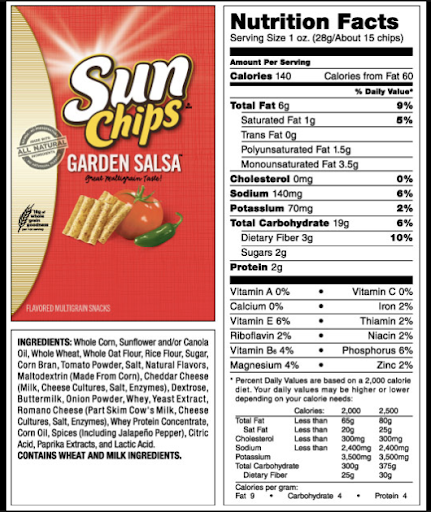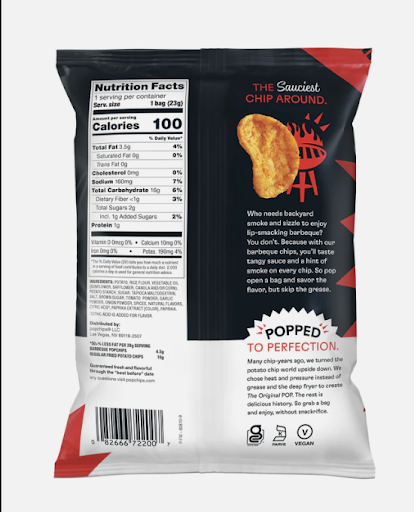Current statistics indicate that only half of the global consumer population truly “understands” how to read a food label, with the other half claiming difficulty due to lack of underlying knowledge or confusing terminology used.
As we move toward a more transparency-driven consumer market and food labels as trends have shown in the past couple of years, it’s vital that food and beverage product companies begin to rethink the digestibility and readability of their nutrition facts label (while still remaining in compliance with FDA standards).
Understanding food labeling requirements for nutrition facts label can be a fantastic way to save on production costs while lowering your compliance risks. Going above and beyond FDA nutrition labeling requirements for food product to create an impactful statement that users both appreciate and fully understand is key to establishing long-term brand advocacy and preference.
Below, we’re discussing FDA information panel requirements, the types of panels and content to consider as you formulate your food labels, product label examples showing competent label creation, and the value of a standardized labeling system in your food production operations. We've also cited additional resources to help you properly list information on your food labels package for most packaged foods, helping food manufacturers maintain compliance.
What You Need to Know
No food labels are created alike. Having a consistent, consumer-forward design while still remaining compliant with federal food laws and FDA standards are key to having a sustainably profitable product. We’ve listed key points to your entire package food label below for further optimization and consideration.
Principal Display Panel
This part of your packaging is likely what your consumers are most familiar with. Here, you’ll have your branding and design pieces, as well a common or usual name for the packaged food product. You'll also be able to check the nutrition facts panel (either here or on the back) to identify ingredients such as food product coloring, saturated fat, vitamin D and other key areas of consideration.
There are standards around the content on the principal display panel (PDP) that must be kept top of mind in the design process. For example, you’ll want to consider:
- Your food’s identity: This is generally defined as the common name you use for your product. You’ll want to choose a common name that is as truthful as possible, prominently displaying it on your PDP.
- The accessibility of your print: Consider choosing a bold, large type font for your common name and other critical information on your PDP. Ideally, you’ll put this front and center on your food label, unobscured by other design elements.
Net Quantity of Contents
This information is required to be listed on your PDP, totaling the minimum amount of food product in any given package. This is different from the serving size, which can identify the proper amount that one ought to eat in a sitting.
This net quantity (net qty) weight value is calculated in either fluid ounces or ounces by weight, and is not to include any elements that could be calculated in the tare weight, such as boxes or packaging.
Ingredient List
.jpg?width=1827&height=875&name=Untitled%20design%20(36).jpg)
Ingredients lists must be comprehensive in nature, and are generally listed in the order of use by weight. There is generally just one ingredients list per any one package, keeping information easy to read for consumers. For example, if you see wheat flour as the first ingredient on a box of pasta, that is the ingredient that has the most weight in any given iteration of the product formulation.
Ideally, your ingredients list will sit just under the nutritional panel for continuity and ease of access. You can also choose to place it on the right of the box if there is not space to keep it in its primary position. Clearly mark the ingredient list and list any sub-ingredients in parentheses to properly organize the information.
Distribution Information
Name and location of the manufacturer must be located in the PDP or information panel, respectively. You should list the name of the business rather than the name of any individual.
Nutritional Information
Nutritional information is required to be clearly labeled on all food and beverages available for commercial consumption. This tool is used to inform consumers about the nutritional content that they are consuming when they choose to indulge in your product. It's also a valuable tool for those living with medical illnesses that require them to keep careful watch on their intake — such as diabetes or obesity.
Depending on the packaging, this won’t be on the front area of your PDP, and may be housed on the back panel. Key information such as the presence of added sweeteners, the name of the food, recommended limits and the serving sizes will be located in this single convenient area, as well as any other relevant information about other ingredients and total sugars.
We do want to note that nutrition facts labels information is calculated by single serving increments, calculating based off of the serving size and daily values. Daily values, otherwise known as DV, are set forth by the FDA across all food products — tracking important nutrients.
They are used to encourage people to choose foods that have nutrients that go toward their percent daily value of certain key intake elements, such as total carbohydrate counts, trans fat, added sugars and protein. DVs can help consumers understand proper serving size and nutrition information, promoting a higher quality of life.
Depending on the packaging, this won’t be on the front area of your PDP, and may be housed on the back panel.
FDA Ingredient Labeling Requirements
.jpg?width=542&height=542&name=Untitled%20design%20(37).jpg)
The Food and Drug Administration plays a vital role in standardizing the presentation and requirements of all food labels. Their site(s) do have valuable information regarding the specifics of the labeling requirements over several key areas: such as net quantity calculations, ingredients lists, and manufacturer information. We’ve summarized key details below:
- Net quantity calculation: This is done by food type, such as volume calculations (for liquid products) and weight (for solids). Recommendations currently state to list this information on the lower third visual area of your PDP.
- Ingredients lists: This can be a difficult element of design and formulation if your company works with highly complex food items. The Code of Federal Regulations (CFR) has released guidance that offers valuable insight into the proper use of shortened names, updated as recently as February of 2023. Even if a company chooses to use shortened names, they should be listed in descending order from their amount of use. This remains true across all food products.
- Manufacturer information: If you are distributing outside of the parent entity as a third party, this also must be announced.
More information can be found directly on the FDAs website.
Types Of Panels
There are many different types of panels that you can leverage to provide high-quality and transparent information to your consumers. We’ve summarized different types below:
Information Panel
The information panel is generally situated just to the right of the primary display panel, or PDP. There is a lot of flexibility regarding what is actually allowed in this space of packaging. Manufacturers may choose to include:
- Relevant branding information: Information such as the manufacturer’s name and address, as well as any manufacturer’s statements regarding the food production process can go in this panel. This can be used to report a food safety concern, incorrect information on the nutrition facts labels and other concerns.
- Food Safety information: Allergy information can be expanded on in this area, even if it is already acknowledged in the ingredients list. This can be a great use of space if your product serves folks who struggle with allergies (such as those living with Top 9 vulnerabilities) — or even if it’s more run of the mill — offering a transparent overview of what the consumer can expect when they choose your product.
- Instructions: You’ll want your consumers to experience your product as it was meant to. Cooking instructions can help them to get the full experience with your product every time, and can go a long way to preventing foodborne illness. You might consider consulting with legal experts to ensure that all relevant disclaimers and information are listed to lower your liability.
No matter what you choose to list here, the FDA does mandate the use of an accessible print typeface and size, as well as spacing that clearly displays all information listed.
Rear Panel
The rear panel is a general term that encompasses both the nutritional information panel and the general information panel to the right, both of which are generally not shown on the PDP. Designs and locations may vary depending on the food type and choice of packaging.
Net Weight Label And Packaging
The net weight label on packaging consists of data from the net quantity calculation, which is calculated to be the total raw weight of the food in any given quantity. Tare weight elements are removed from the final net weight label. In many cases, the net weight is shown in the PDP based on most recent food nutrition facts label requirements, and it may be restated on the back.
Examples Of Product Labels
Chips and other uniform “snack” foods are great examples for proper product label form. We’ve included a few examples and relevant commentary on nutrition facts requirements below.

Source: Sun Chips
The image shown above is a fantastic example of a well-constructed PDP. All information is completely legible and recognizable, satisfying nutrition facts food label requirements and marketing best practices. You can clearly see the net weight label found at the bottom area of the PDP, calculating the amount of product in the bag. Key nutritional information is called out in a user-friendly way, using graphic imagery to capture the attention of the consumer.
To the rear of the PDP, you’ll find a properly formatted ingredients list. All ingredients listed are in the proper order, based on the quantity used in production. There is a clear allergen warning listed on the bottom, keeping users as safe as possible. There is also clear nutritional information listed to the side, covering all the mandatory bases.

Source: PopChips
PopChips is another company that has successfully leveraged the power of their PDP and back panel to grab the consumers attention while covering all legal labeling requirements.
Beyond the easy-to-read nutritional panel and compliant ingredients list, we see the manufacturer information clearly printed just above the barcode. We also see great use of the information panel for extra marketing power and an easily-recognizable allergen-free callout.
Conclusion

Looking for support for corporate food labeling requirement support? Connect with the team at Inecta today. Our ERP for food and beverage manufacturers has native tools to help automate and standardize your process, saving you significant labor and resource costs. Visit our website today to book a demo and see what Inecta can do for you.











Free Valuable Resource!
3 simple steps to find your Food ERP
Free Valuable Resource!
3 simple steps to find your Food ERP
*We will never sell your information. Keeping your data and privacy secure is our highest concern.